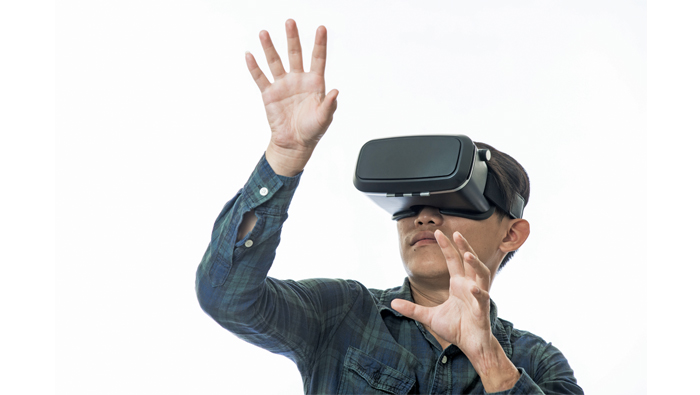
Dating its conceptual origins back to the pre 1950 era, the dawn of Virtual Reality (VR) is now upon us. The iconic tech giants are already battling for market share in the industry expected to rise well above the billion dollar mark by the turn of the decade. Recently heavyweights Google, Sony, and Samsung have released VR headsets that offer incredible 3D experience of a simulated environment. If one has been in a small module in kids’ entertainment parks with weird names such as 7D, they are slightly acquainted with the concept of Virtual Reality.
The idea is to create an environment which isn’t reality but a simulated world with the objective of immersing the individual into it to the extent that the brain perceives it to be real, unlike when on TV or computer. It is basically a computer generated interactive simulation of a certain environment using electronic devices such as gloves, helmets, goggles, and provides some of the most memorable experiences to users who can find themselves as astronauts on Moon or combatants in a battlefield, all in their living rooms.
But how do they achieve this? In theory it is very simple. There are essentially three things required, a console, PC or a Smartphone to run the application or game, a headset that allows the display to be secured in front of the eyes and an input including sensors, head tracking, and hand tracking.
The visual input is provided by the PC or console through an HDMI cable or by the Smartphone itself depending on the type of Head Mounted Display (HMD). These displays, often referred to as goggles due to lens fitted into them, contain LCD displays for each eye or receive two feeds to one display. The lens placed between the eyes and the visual input help in focusing on the image to create a stereoscopic 3D vision by capturing the same image with different angles, identical to how the eyes perceive the real world.
Even the field of view is important in VR to mimic the real world much as possible, which is a 180 degree view when both eyes are open. The closer it is to the human eye perception, the more immersion for the user. Most headsets currently provide a 110 degree field of view which is nearly enough for the total captivation of the user into the simulated world.
So far, following are our gateways to the virtual world:
HTC Vive: By far the most comprehensive VR package in the market, in terms of the immersive experience including motion sensors that track the motion of head with a crisp 1080p display, is the cordless HTC Vive, able to play movies and games. The outstanding feature in the Vive is that it allows movement in a room 4.5x4.5m so instead of moving a joystick, you can move around with your legs. Be careful not to run into walls, that is if you have an empty room of that size. On the downside, the HTC Vive is rather expensive and requires a high end GPU discouraging customers to procure it.
Pros: Best VR experience, Motion sensor enabled
Cons: Requires a high-end GPU, Expensive
Sony Playstation VR: The cabled VR is compatible only with the PS4. The unbeatable aesthetics and indulging display of the PSVR are a boon only for a PS user. For the others, doesn’t sound as good of a prospect considering one would have to buy the gaming console as their dedicated GPU. The enthusiasts may have to wait for it as it is available for pre-order and arrives in October 2016.
Pros: Excellent level of interaction, 120Hz refresh rate
Cons: Only works with PS4, Can cause motion sickness
Oculus Rift: The revolutionary VR manufacturer produces one of the lightest and most comfortable VR headsets available. Even though its wired and lacks motion sensors creating a rather static virtual experience, the Oculus Rift makes up for it with a high quality experience with a smooth image input preventing eye strain. It plays both movies and games and is comparatively cheaper.
Pros: VR pioneers
Excellent quality and experience
Cons: No motion controls
Google Cardboard: The most basic of the VR headsets is the Google cardboard. The best part is, you can nearly make it yourself. Yes, as the name suggests, it’s just cardboard attached to a Smartphone. All you have to do is construct the headset as per the instructions and slot your phone into it. The experience may be far from an immersive one but if you have a high resolution phone, you could have a decent one.
Pros: Cheap, as in very cheap, Hobbyist fun
Cons: Quality far from premium, Limited Functionality
Samsung Gear VR: Powered by the Oculus technology, the Samsung Gear VR promises to provide a decent VR experience, though considering its wide range of compatibility with different Samsung devices, the image quality is always subjected to the phone. Playing both games and movie, like Vive, it is completely wireless.
Pros: Value for money
Cons: A bit bulky, low interaction, content pixelated
Constant developments in technology including motion sensors, head tracking, sound and eye sensors can make Virtual Reality as immersive as reality. It certainly has an appeal to a huge audience and with more advancement; days of TV and computer for visual entertainment may be numbered. After all, who doesn’t want to escape the real world?